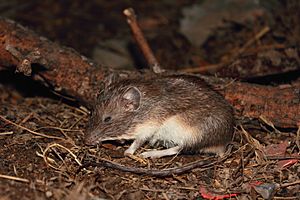Mexican spiny pocket mouse facts for kids
Quick facts for kids Mexican spiny pocket mouse |
|
|---|---|
 |
|
| Heteromys irroratus texensis | |
| Conservation status | |
| Scientific classification | |
| Genus: |
Heteromys
|
| Species: |
irroratus
|
The Mexican spiny pocket mouse (Heteromys irroratus) is a small rodent that lives in Mexico and Texas in the United States. It's called a "pocket mouse" because it has special cheek pouches, like tiny pockets, for carrying seeds and food. This mouse prefers dry, bushy areas. Scientists used to put it in a different group called Liomys, but now they know it belongs to the Heteromys genus. The good news is that its population is stable, so it's not currently in danger of disappearing.
Contents
Meet the Mexican Spiny Pocket Mouse
There are seven different types, or subspecies, of the Mexican spiny pocket mouse. This means they can look a bit different in color and size depending on where they live. Generally, this mouse is a medium-sized member of its group. Its head and body are about 12 cm long, and its tail is about the same length.
The mouse's fur, called its pelage, is a mix of stiff spines and soft hairs. The spines are the most noticeable part because the soft hairs lie flat. The top part of its body is grayish-brown, and its belly is whitish. A pinkish or buff-colored line separates these two colors on its sides. Young mice are grey and don't have spines at first; these grow in later. The bottom of their feet are covered in hair. What makes this mouse special is that it has five small bumps, called tubercles, on its back feet, while other mice in its group usually have six.
Where Do Spiny Pocket Mice Live?
The Mexican spiny pocket mouse is found only in certain parts of Texas and Mexico. This means it is endemic to these areas. Its home range stretches from just north of the Rio Grande river all the way south to the Mexican Plateau. The furthest south it's found is in a place called Zapotitlán in Oaxaca, Mexico.
You can find this mouse in dry shrubland, sometimes as high as 3,000 m up mountains. In areas where its home overlaps with the painted spiny pocket mouse, the Mexican spiny pocket mouse prefers drier, higher places. It usually doesn't live in areas that get less than 50 cm of rain each year.
What About Parasites?
The Mexican spiny pocket mouse can sometimes have a parasite called the mouse botfly (Cuterebra fontinella).
How Do Spiny Pocket Mice Behave?
The Mexican spiny pocket mouse uses four different ways to move around. The fastest way is a special leaping jump, like a kangaroo. When it does this, the mouse can cover 1.5 m in just one second!
This pocket mouse is nocturnal, meaning it is active at night. During the day, it rests in its burrow. The entrance to its burrow might be hidden with leaves or a small pile of earth.
Its diet mainly consists of seeds, especially from hackberry trees, mesquite, and other trees and shrubs. It collects these seeds in its cheek pouches and carries them back to its burrow to store them. Studies have shown that these mice need access to water to stay healthy and keep their body weight stable.
Reproduction and Life Cycle
Mexican spiny pocket mice can have babies for most of the year. However, they seem to have the most babies between August and November. A mother mouse usually has a litter of two to eight young, with four babies being a common number.
Conservation Status
The Mexican spiny pocket mouse lives in a wide area and is common in places where the habitat is suitable. The number of these mice seems to be steady. No major threats have been found that would put them in danger. Because of this, the International Union for Conservation of Nature (IUCN) lists its conservation status as "least concern". This means it's not currently at risk of disappearing.
See also
 In Spanish: Liomys irroratus para niños
In Spanish: Liomys irroratus para niños


